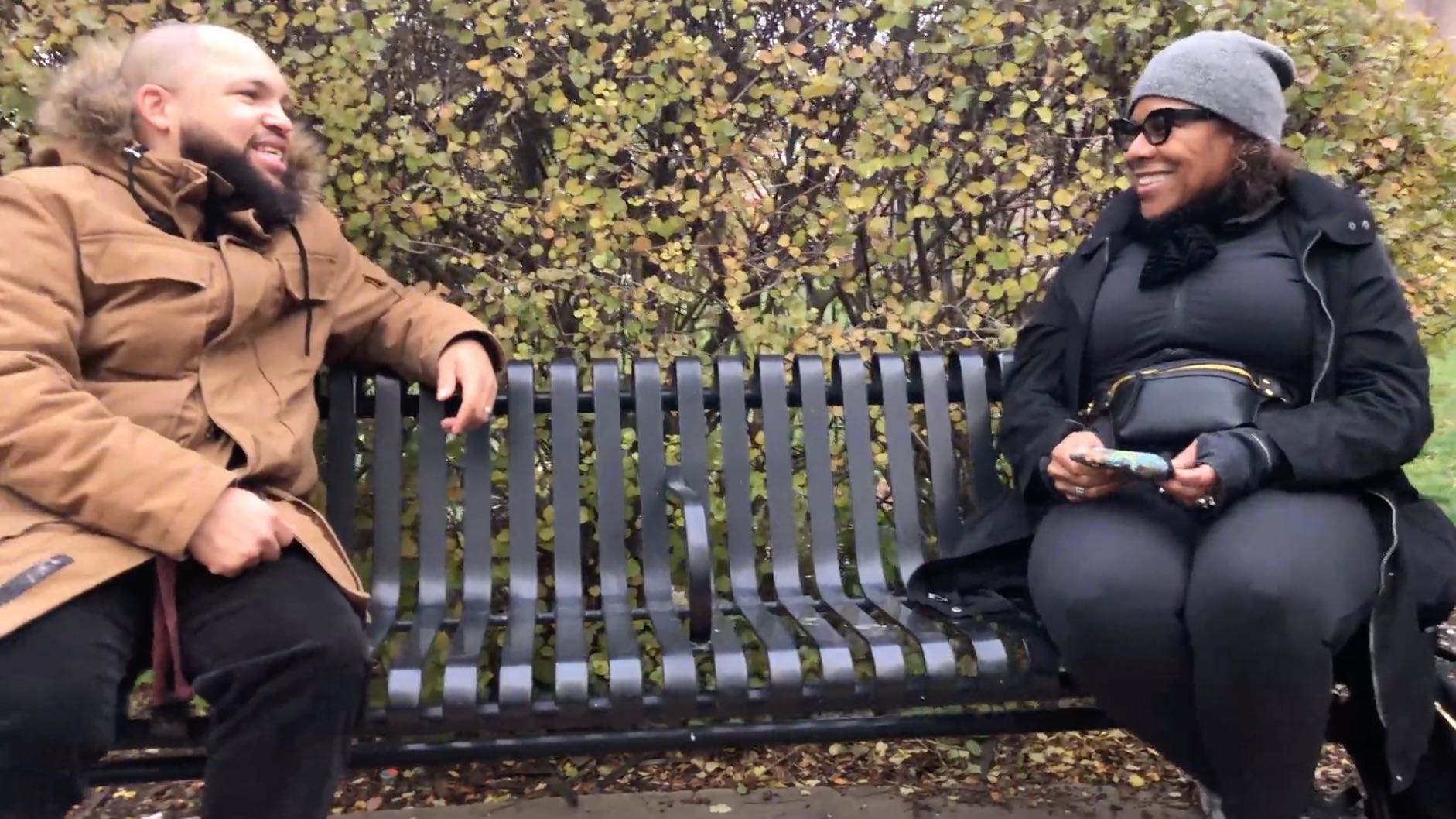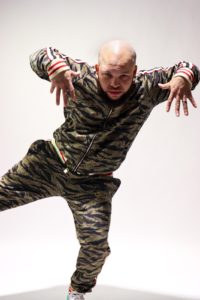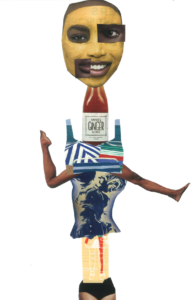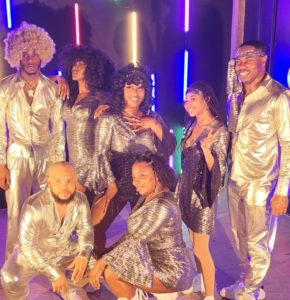
Still from “The Lighthouse,” Filmed by Ozilamont Media Solutions
[ID: Both artists are seated on a black bench at a park. Mad Dog, a Black man, wears a tan-colored winter jacket with a fur collar. Brenda Butler, a Black woman, wears all black and a gray knit cap. Both are smiling as they converse.]
Editor’s note: Brenda Butler and Christopher “Mad Dog” Thomas first met in 2020 through For You’s A Bridge, A Gift, a project that paired artists and elders with ties to Chicago’s Southside neighborhood and offered them creative prompts for their exchange. For this In Dance issue I invited them to reconnect. The following linked reflections were written in response to their recent conversation.
[by Mad Dog]

[ID: Mad Dog is a light-brown skinned bald Black man in the middle of a hip hop movement with his arms raised parallel to his shoulders with his fingers widely splayed facing downwards. He is raised up on one foot with the other leg bent in the air. He wears a camouflage patterned sweat suit against a white background.]
To me dance is how I get free. Growing up in Altgeld Gardens housing project, urban dance was something that was part of our culture.
The death of disco at Chicago’s Comiskey Park in 1979 inspired the Chicago House scene, which grew into the Chicago Juke/Footwork community, which is centered around House/Juke music. In Juke/footwork there’s a constant syncing up of the movement and the music, a constant rapid-fire exchange.
Juke music and movement is a direct reaction to violent and under-resourced living conditions. The Chicago footwork cypher allows dancers to express their traumas, and communicate their stories through movement. This dance movement allowed youth to build community and challenge the negative narrative about young black and brown youth in the city of Chicago.
Footwork means the world to me! This art form has allowed me to be in places that I couldn’t believe I would be. In 2016, I took an internship with Chicago Public Allies where I had an opportunity to work and develop skills in the corporate not-for-profit field. My dance background and years of youth advocacy really helped me navigate the space. During my two year internship, I became a board member of the Chicago SNCC (Student Nonviolent Coordinating Committee) History Project. Led by Dr. Fannie Rushing, the project really believed self education works best when you work in an intergenerational setting. Here I learned so much about my history and the elders who were on the front lines of the civil rights movement, like Willie Ricks and Fannie Lou Hamer. This opened a new scope of work for me that is centered in liberation and reimagining a world without police and systems of oppression.
Dance has always allowed me to bridge the gap between any form of adversity that I have ever faced. I’m dyslectic and struggled academically, but because of my ability to dance people were willing to invest in me and wanted to see me succeed academically and artistically.
[by Brenda]

[ID: Brenda Butler is a medium-brown skinned, older Black woman with reddish-brown curly hair smiling at the camera with her left hand posed under her chin. She wears a black suit against a black background.]
I wish I could dance better. I wish I could dance well.
But that is not/was not my profession. Nor my inclination. Though I was a disco queen.
Growing up I never saw my parents, a schoolteacher and postal worker, dance. They worked a lot.
In high school and college, the Twist, the Boogaloo, the Monkey, the Twine were easy to approximate.
And my homies Archie Bell and the Drells of Houston, Texas (“we dance just as good as we walk”) were so smooth that the Tighten Up could be danced standing in place.
Easy.
Disco era was a matter of doing your thing but you had to learn certain dances to choreograph with your dance partner. Hey, stepping, Chicago-style, bring it on.
The dance floor was the stage. It was electrifying. It was a ball far beyond that disco ball.
I despise the anti-disco movement that originated in Chicago. I wonder now what that was a precursor to? Slamming the music and clubs that brought all kinds of people together. Sound familiar? After the so-called death of disco, dancing as a release and a fun time migrated to the neighborhood clubs or private dance sets. And slowly, the clubs fell away.
Now, I feel the urge to dance again. To explore.

[ID: A collage with images of women in various fashions and forms in a totem pole format. The images are layered on top of each other against a white background.]
I watch other dancers: Like you, Mad Dog of Kuumba Lynx.
And the Alvin Ailey dancers, the Dance Theatre of Harlem, Michael Jackson, Gregory Hines, Savion Glover, Janet Jackson, Broadway musical theater, The Temptations, J-Lo. En Vogue. Give me Beyonce. And Bruno Mars.
Through memories of late-night old movies in elementary school and junior high: Ginger Rogers and Fred Astaire. Gene Kelly and Donald O’Connor. Eleanor Powell. Bill “Bojangles” Robinson. The Nicholas Brothers. Those splits.
And most recently correcting history or embracing it, we are learning of the influencers and trendsetters like John “Bubbles” Sublett and Katherine Dunham.
To move like all that.
Simply watching is cathartic, a release, pure enjoyment. This must be a kind of wellness because I feel so full and elated after the dancer takes a bow. I never thought that just seeing the movements of a dancer could provide a connection. But that is what dance is about. Movement. Expression. Performance.
A catharsis for the dancer. A revelation to the watcher. Even though you the seer are not physically dancing, you are indeed a partner.
So now. I am retired and I want to dance. Gotta dance. Oh, I’ll do my thing in the living room to my Pandora music or my retro CDs.
But I want to take a class. No ballroom for me. Maybe a few steps like Mad Dog but I’d prefer to slow it down, to channel Judith Jameson in one moment or Janet Jackson and Beyonce in another. Just to start. To enroll and engage. For relaxation, for expression, for purpose, power and pleasure toward a commitment to explore something new.
To my health, to our health. Be well.
[by Mad Dog]

[ID: Mad Dog and a mixed group of dancers are posed in all gold attire reminiscent of disco days including afros and jumpsuits. They are posed on a stage with neon lights behind them.]
My mother used to take me to house parties and have me dance for her friends. A lot of them were also dancers who would teach me moves. In Chicago, during the ‘90s, there were dance groups everywhere. We had “dance downs” every Saturday at different parks across the city. This is how youth from all over the city were able to build community and establish healthy relationships.
Boogie Wonderland is my favorite song from the disco era, and the name of my current dance film project. The video will not only showcase my love for the era and highlight the moment when footwork/urban dance met disco. But also allow me to highlight some of Chicago’s black women and LGBTQ dance choreographers who are overlooked. The footwork dance battle scene is dominated by straight men. This leaves little room for women and LGBTQ folks. My hope is that Boogie Wonderland will lead to some healthy conversations within Chicago dance communities about the need for inclusive safe space for dance regardless race, sexual orientation, gender, and age.
Today we have a new wave of simple dances that are similar to some of the dances Brenda spoke about. TikTok has created a space for everyone to participate in dance and urban culture. What’s funny is that I have a very hard time learning the simple TikTok dances, but my son Travon is killing it!
And yet, the TikTok space isn’t enough. How do you get your spiritual healing, your wellness–with your community and people who are outside of your community–when there’s no equitable space to be well?
I feel the fight for equity has to come from us. My Juke For Liberation Project is centered around educating dance and DJ leaders to use movement and music to create social change. In Chicago we are going through a lot of redevelopment that is having a major impact on black and brown dance communities. We all need a safe space to dance and express ourselves. But are we as a community willing to fight to provide dance and wellness for those black and brown youth who don’t have a space to get free?
For the past 17 years Christopher “Mad Dog” Thomas has been the program manager and creative director for Kuumba Lynx, a Hip Hop and performing arts organization. His artistic inquiry is deeply rooted in social liberation through artistic expression, and footwork is his primary dance form to convey that message. He is KL’s head dance choreographer, and he creates theater productions with youth from across Chicago covering social and economic issues in the city and around the world. Mad Dog received a 2020 Chicago Dancemaker award and a 2022 Johnson Fellows for Artists Transforming Communities award from Americans For the Arts.
Brenda Butler is a three-term president of NABJ (National Association of Black Journalists)-Chicago and an experienced journalist with 35+ years in newspapers and magazines. At the Chicago Tribune she was involved in the conception and development of newspaper sections and magazines and co-managed a staff of over 100 reporters, editors and support staff. In the late 1990s, Butler also wrote, produced and moderated a series for Chicago cable TV titled “Playback: Views from an African-American Perspective.” For 7 ½ years, she was executive director and a high school journalism educator for the Columbia Links program at Columbia College Chicago.


